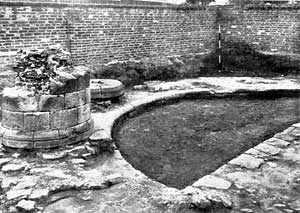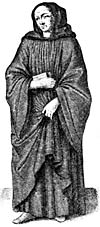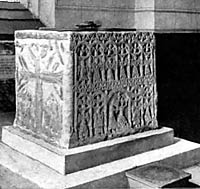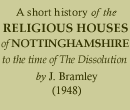< Previous | Contents | Next >
Lenton Priory
 |
| Lenton Priory. General view of excavations from the North (1936). |
The Priory of Holy Trinity, Lenton, on the western outskirts of Nottingham was the only Cluniac House in this county, and from time to time the townsfolk would see the monks when in town on monastery business. The Cluniac monk wore a black frock or cassock, white woollen tunic and a black scapulary. It was fortunate for Nottingham that Lenton Priory was built outside the borough, as if a monastery was built inside a borough trouble usually arose between the superior of the monastery and the borough authorities on matters of local government. The Cluniacs followed the Rule of St. Benedict as interpreted by Berno, who founded the Cluniac Order at Cluny in East Central France in 912. The foundation of this new Order is generally recognized as a revival actuated by a desire to follow more closely the Rule of St. Benedict, with certain adaptations. Unlike the other Orders hitherto founded, the Cluniacs were dependent on the Head House, and the head of Cluny appointed the heads of any monasteries of this Order founded elsewhere. This made it an alien Order and the fact that the dependant houses in England sent considerable sums of money to Cluny, resulted in such houses being taken into the king's hands when we were at war with France, and in some of them being suppressed towards the end of the fourteenth century, and later, in most of them freeing themselves from foreign allegiance and securing denizenship, as Lenton did in 1392 in return for paying 500 marks. Cluny was a vast organization and till St. Peter's Church was built at Rome it was the largest ecclesiastical building in Europe, its abbots ranking next to the Pope in the ecclesiastical sense.
 |
| Cluniac monk. |
The Priory was founded by William Peveril about 1109 and richly endowed by him and later benefactors, till in 1291 its annual income was £339 and it became the richest in this county. Among other privileges it had the right to hold a fair at Lenton, lasting at one period for twelve days, and the monks levied toll on most goods sold in the fair. They also had the right to the first draught of fishes in the fishing of Chilwell — a valuable right at a time when salmon were common in the Trent. At another period complaints against the priory could be tried only before the king or his chief justice, which must have greatly reduced the number of complaints.
The history of Lenton Priory does not differ greatly from that of the others, except for the circumstances which brought about its end. It is the only religious house in our county which has been deemed worthy of an extended history. In 1263 William, son of Nicholas de Cantelupe of Greasley Castle, was born in this priory. Women were not admitted to the monasteries and it therefore seems probable that William's mother was accommodated in a building not technically part of the monastery in order that William might make his debut 'off the premises'. It is known that the Cantelupe family home was being rebuilt about the time young William arrived. Among other guests the priory entertained at different times no fewer than four kings of England. The records certainly indicate that these monks were more than ordinarily litigious, and one case in which they disputed with the Chapter of Lichfield dragged on for some three hundred years, and in 1250 resulted in bloodshed in Tideswell Church. In 1263 the prior presented an incumbent to the living of St. George, Barton-in-Fabis, Notts., during the tenure of the then incumbent, thereby precipitating a brawl in the course of which the rector's proctor was killed in the churchyard. For his share in this very unclerical act the prior and another were excommunicated until they made "condign satisfaction". There are several records of the priory being in debt, although four years before it was dissolved they were about £60 on the right side. The prior from 1414-1427 was Thomas Elmham, supervisor of all the Cluniac Houses in Great Britain, a royal chaplain, who was present with King Henry V at the Battle of Agincourt in 1415.
 |
| Lenton Priory font. |
The number of monks at Lenton at the date of the Dissolution is unknown but three years earlier there were several under the normal age and several who were old and impotent. One of the monks named Dan Hamlet Penkrich has achieved a niche in history as he is reported to have absconded three times and to have returned penitent after each of those excursions. Three apostate monks were wandering about in 1350. The number of monks in 1262 was twenty-two and two lay brothers, and in the last year of the priory's existence the number would certainly not be in excess of those figures.
Four hundred and thirty years after the founding of this great priory Nicholas Heath, the last prior, and one monk, were found guilty of high treason and executed in Nottingham or in front of the priory in 1538. As the priory was dissolved by attainder, the inmates did not get pensions. In 1539 Michael Stanhope leased the priory site and certain adjacent lands for forty years for £38 13s. Ad. per annum. Excavations on the site have revealed some remains of the noble structure which at one time stood at Lenton for all to see.
